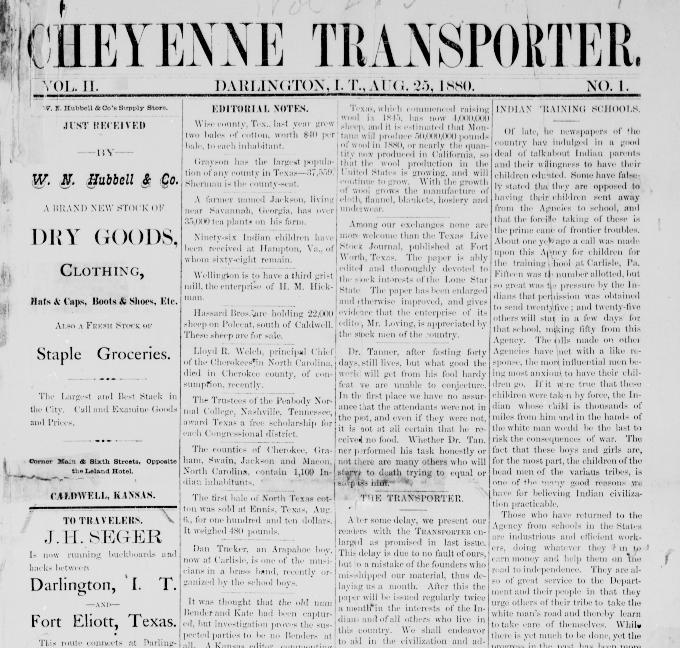|
Moderated by NW Okie! |
Volume 15 , Issue 382013Weekly eZine: (374 subscribers)Subscribe | Unsubscribe Using Desktop... |
Cheyenne Transporter of Darlington, I.T.

The Cheyenne Transporter was published in Darlington (Canadian county), near present day El Reno, Oklahoma. The Cheyenne-Arapaho Agency printed the first issue on December 5, 1879. The four-page 5½ x 7½-inch, semimonthly paper was notable on two accounts: 1) it was the first newspaper published in what became Oklahoma Territory; and 2) one of the few publications ever issued at an Indian agency.
The Treaty of Medicine Lodge (1867) had relocated the Cheyenne and Arapaho to Indian Territory. The Darlington Indian Agency, established in 1868, served the newly relocated tribes. Mennonite and Episcopal missionaries soon followed, building schools and churches. In 1879, Reverend Alfred Brown, superintendent of the Arapaho school and agency employee, John Homer Seger, organized an amateur entertainment night to raise funds for the school children to purchase a magic lantern. With extra money earned, Seger acquired a small printing press. With Reverend Brown as editor, the Cheyenne Transporter was launched in the interest of Indian Civilization and Progress."
The agency and school employees purchased a larger press on a joint-stock plan in August 1880 and relocated it to the attic of the agency sawmill. However, expenses soon overwhelmed the stockholders. To keep the paper solvent, the agency donated the press and office to its new printer William A. Eaton on the condition that he publish the Transporter. The first issue under Eaton's management appeared on August 25, 1880.
Darlington, near Fort Reno, thrived as a frontier hub due to a wagon line created by Seger. Eaton was able to support the paper through print jobs and advertisements sold at Arkansas City and Caldwell, Kansas. By 1881, the Transporter had grown to eight, 22 x 31-inch pages and boasted a circulation of 384. On May 10, 1882, George West Maffet--a printer from the Republican in Anthony, Kansas--succeeded Eaton as editor and publisher. Lafe Merrit, who in 1894 founded the El Reno Globe, became Maffet's assistant and local editor. They made improvements, wrote editorials, and added articles by Seger, now Superintendent of the Darlington school. In 1883, the Transporter moved to a specially built facility.
In 1885, Merrit became Maffet's partner. As circulation of the Transporter approached 1,000, it acquired the subtitle, "Indian and Stock Journal." The paper opposed opening the territory for white settlement and called on the government to protect the interests of Indians and the cattle industry. That same year, hostilities broke out between the Indians and newly arriving Boomers. U.S. Army Captain Jesse Matlock Lee temporarily commandeered the agency, started an investigation, and expelled many of the illegal settlers. Businesses in the territory were thereafter required to furnish approved bonds to obtain an operating license from the Department of the Interior. The Cheyenne Transporter presented a $10,000 bond and obtained a license; however, within a year the newspaper was suspended due to Indian unrest following Captain Lee's departure. Publication never resumed, making August 12, 1886, the final issue of the Transporter.
First Issue Under W. A. Eaton
In the first issue under Eaton, Wednesday, 25 August 1880, there was mentioned in the Cheyenne Transporter Editorial Notes there was mention of the Bender family where old man Bender and Kate had been captured, but investigation proved the suspected parties to be no Benders at all. A Kansas editor, commenting upon the arrest, gave the comforting assurance that the real Benders had been in their graves for years.
Also mentioned in the "Editorial Notes" was 120 of the Uncomphagre and 36 White River Utes, had signed the treaty. The Commission had gone to the Southern Utes Agency. Chief Ouray went by trail to join the Commission at that point and assisted in obtaining the consent of the White River Utes to the treaty. col. Mealeham remained to take a census of the Umcomphagre Utes.
| View or Add Comments (0 Comments)
| Receive
updates ( subscribers) |
Unsubscribe
| © . Linda Mcgill Wagner - began © 1999 Contact Me | |
